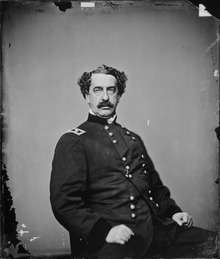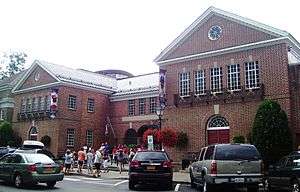Doubleday myth

| Part of a series on the |
| History of baseball |
|---|
| By country |
| Other topics |
| Related games |
| Baseball portal |
The Doubleday myth refers to the belief that the sport of baseball was invented in 1839 by future American Civil War general Abner Doubleday in Cooperstown, New York. Abner Graves presented a claim that Doubleday invented baseball to the Mills Commission, a group formed in 1905 that sought to prove whether the sport originated in the United States or was a variation of rounders. Graves' evidence was accepted by the Commission, and in 1908 it named Doubleday as the creator of baseball. The claim eventually received criticism, and most modern baseball historians consider it to be false.[1] The myth nevertheless led to the National Baseball Hall of Fame and Museum's being located in Cooperstown.
Background
In the late 19th century and early 20th century, a dispute arose about the origins of baseball and whether it had been invented in the United States or developed as a variation of rounders,[2] a game played in Great Britain and Ireland.[3] The theory that the sport was created in the U.S. was backed by Chicago Cubs president Albert Spalding and National League president Abraham G. Mills. In 1889, Mills gave a speech declaring that baseball was American, which he said was determined through "patriotism and research"; a crowd of about 300 people responding by chanting "No rounders!"[2] The rounders theory was supported by prominent sportswriter Henry Chadwick, a native of Britain who noted common factors between rounders and baseball in a 1903 article.[4] In 1905, Spalding called for an investigation into how the sport was invented. Chadwick supported the idea, and later in the year a commission was formed. Spalding instructed the commission to decide between the American game of "Old Cat" and rounders as baseball's predecessor. Seven men served on the commission, including Mills. Spalding chose the committee's members, picking men who supported his theory and excluding supporters of the rounders claim, such as Chadwick.[5]
Myth
Abner Doubleday was an officer for the Union during the American Civil War, who saw action in the Battle of Gettysburg.[6] According to the myth, he set up the first baseball game in approximately 1839, in Cooperstown, New York. The April 4, 1905, edition of the Akron Beacon Journal newspaper included the first story that described the legend.[7] Mining engineer Abner Graves made that claim in the press; he had written a letter stating that he had seen Doubleday create a diagram of a baseball field, in response to a request by Spalding for information on early baseball that had been published in the Beacon Journal.[8] The letter, dated April 3, stated that Doubleday had invented baseball as a modified version of town ball, with 11 players per team and four bases on the field. It listed the names of seven players from an early game that Graves claimed to have seen.[9]
The myth received coverage in the Sporting Life newspaper later in 1905. Spalding wrote a letter to Graves asking for evidence to back up his claim; Graves responding by sending a diagram matching the one he said Doubleday had drawn, along with a letter stating that the original had not been preserved and that most of the players at the time were no longer alive.[10] A December 30, 1907, report by Mills gave Doubleday credit for originating baseball and said that the sport was American in origin.[11]
An extension of the myth developed later involving the growth of baseball in Mexico. Doubleday, who was in the country as part of the Mexican–American War, was alleged to have organized games for military camps, which drew interest from Mexican spectators.[12]
Criticism
Many baseball historians have considered the Doubleday story faulty. The recollections of Graves, who presented the story of Doubleday's contributions, have been criticized because Graves was five years old in 1839.[1] He also expressed anti-English sentiments in a letter to the Mills Commission, and spent time in an insane asylum late in his life.[13] In addition, Doubleday was never in Cooperstown during the year he is said to have created baseball. Instead, he spent the year at West Point, New York, as a United States Military Academy (USMA) plebe.[1][14] It is unlikely that Doubleday traveled to Cooperstown in 1839, as first-year cadets such as Doubleday were rarely given leave at the time.[15] Doubleday himself made only one mention of baseball in his letters or diaries before his 1893 death; the only time the sport appears in his papers dates from 1871, when he penned a request for equipment.[16] A theory expressed by historian Peter Morris is that Graves was referring to Doubleday's cousin Abner Demas Doubleday, a Cooperstown resident when the events discussed in the letter occurred; but Morris denied that Abner Demas had played a role in baseball's creation.[13] Mills, despite having been around Doubleday during the Civil War and later, mentioned no personal involvement in baseball before Graves' testimony was released.[17] Spalding also had a connection to Doubleday: he financially supported the Theosophical Society, a group in which Doubleday served as a chapter vice president.[18]
Legacy

Despite criticisms of the Doubleday story, the National Baseball Hall of Fame and Museum was built in the town that served as the location of Doubleday's alleged first game, Cooperstown.[19] Around 1934, a baseball said to be from Graves' family was found and purchased by Stephen Carlton Clark, a powerful figure in Cooperstown who created a museum exhibit around it. Although the myth was criticized after a Hall of Fame had been proposed in connection with the new Cooperstown museum, the Hall was built in that town. Prior to the Hall's creation, a baseball stadium—Doubleday Field—was erected and named in honor of the game's alleged birth in Cooperstown.[20]
A committee from the New York State Legislature traveled to Cooperstown in 1937, and its subsequent report declared that the town was "the birthplace of baseball" and recommended a 100th anniversary celebration in 1939; events that were held included the dedication of the Hall and an all-star game.[21] Prior to the ceremonies, the Doubleday claims were criticized by multiple parties: author Robert Henderson wrote that rounders and baseball were related, and Alexander Cartwright's son Bruce reported that his father had invented the sport.[21] (Some sources have reported that fourteen years later, in 1953, the United States Congress formally recognized Cartwright as the inventor of modern baseball, but no documentation of such a declaration exists in the Congressional Record.)[22] As part of Bruce Cartwright's efforts, the manager of Honolulu's Chamber of Commerce sent Hall promoter Alexander Cleland a letter that questioned Graves' account. In response, Cleland promised that a "Cartwright Day" would be included in the anniversary events at Cooperstown,[23] which went ahead as scheduled. Harold Seymour wrote, "Some sports columnists pointed out the discrepancy; others got around it as gracefully as possible."[21]
A local motel is also named after Doubleday, but unlike Alexander Cartwright, Doubleday was never inducted into the Hall.[12] Nonetheless, the Hall supported the Doubleday myth for many years.[24] It was written about in numerous publications, and became well-known among fans.[25] The myth has also received the backing of Major League Baseball commissioner Bud Selig, who said in 2010 that "I really believe that Abner Doubleday is the 'Father of Baseball.'"[19]
More recently, the Hall has made a small step away from the myth; when it announced special events in conjunction with its 75th year of operation in 2013–14, it made the following statement in its official press release:
On June 12, 1939, the National Baseball Museum opened its doors for the first time, in honor of the 100th anniversary of the mythical “first game” that allegedly was played in Cooperstown on June 12, 1839.[26]
References
- 1 2 3 Morris, p. 227.
- 1 2 Seymour (1989), pp. 8–9.
- ↑ Williams, p. 248.
- ↑ Seymour (1989), p. 9.
- ↑ Ryczek, pp. 20–21.
- ↑ "The Doubleday Myth is Cooperstown's gain: Pastoral village has become the heart of baseball folklore". National Baseball Hall of Fame and Museum. Archived from the original on September 26, 2014. Retrieved September 20, 2012.
- ↑ Thorn, pp. 7–8.
- ↑ Thorn, pp. 274–276.
- ↑ Martin, pp. 5, 163.
- ↑ Thorn, pp. 278, 280–281.
- ↑ Seymour (1989), pp. 9–10.
- 1 2 "Great American Myths". Toledo Blade. Orlando Sentinel. June 17, 1984. p. D3. Retrieved October 9, 2012.
- 1 2 Deane, p. 3.
- ↑ Seymour (1990), p. 361.
- ↑ Ryczek, p. 24.
- ↑ Ryczek, p. 16.
- ↑ Seymour (1989), p. 10.
- ↑ Ryczek, p. 26.
- 1 2 Arango, Tim (November 12, 2010). "Myth of Baseball's Creation Endures, With a Prominent Fan". The New York Times. Retrieved September 20, 2012.
- ↑ Deane, pp. 4–5.
- 1 2 3 Seymour (1989), p. 11.
- ↑ Berenbak, p. 34.
- ↑ Martin, pp. 136–137.
- ↑ Deane, p. 5.
- ↑ Seymour (1989), p. 12.
- ↑ "Hall of Fame to Mark 75th Year with Special Events, Commemorations for Diamond Celebration" (Press release). National Baseball Hall of Fame and Museum. June 12, 2013. Retrieved October 20, 2013.
Bibliography
- Berenbak, Adam (Fall 2014). "Henderson, Cartwright, and the 1953 US Congress". The Baseball Research Journal. 43 (2): 34–35. ISSN 0734-6891.
- Deane, Bill (2012). Baseball Myths: Debating, Debunking, and Disproving Tales from the Diamond. Scarecrow Press. ISBN 978-0-8108-8546-2.
- Martin, Brian (2013). Baseball's Creation Myth: Adam Ford, Abner Graves and the Cooperstown Story. McFarland & Company. ISBN 978-0-7864-7199-7.
- Morris, Peter (2008). But Didn't We Have Fun?: An Informal History of Baseball's Pioneer Era, 1843–1870. Ivan R. Dee. ISBN 978-1-56663-849-4.
- Ryczek, William J. (2009). Baseball's First Inning: A History of the National Pastime Through the Civil War. McFarland & Company. ISBN 978-0-7864-4194-5.
- Seymour, Harold (1989). Baseball: The Early Years. Oxford University Press. ISBN 978-0-19-503890-3.
- Seymour, Harold (1990). Baseball: The People's Game, Volume 3. Oxford University Press. ISBN 978-0-19-802096-7.
- Thorn, John (2011). Baseball in the Garden of Eden: The Secret History of the Early Game. Simon & Schuster. ISBN 978-0-7432-9403-4.
- Williams, Victoria (2015). Weird Sports and Wacky Games Around the World: From Buzkashi to Zorbing. ABC-CLIO. ISBN 978-1-61069-640-1.